
Parallax scrolling is a technique in computer graphics where background images move past the camera more slowly than foreground images, creating an illusion of depth in a 2D scene of distance. The technique grew out of the multiplane camera technique used in traditional animation since the 1930s.

Shadow of the Beast is a platform game developed by Reflections and published by Psygnosis in 1989. The original version was released for the Amiga, and was later ported to many other systems. The game was known for its graphics, with many colours on screen and up to twelve levels of parallax scrolling backdrops, and for its atmospheric score composed by David Whittaker that used high-quality instrument samples.

Wonder Boy in Monster Land, known by its original arcade release as Wonder Boy: Monster Land, is a platform video game developed by Westone Bit Entertainment and released by Sega in Japanese arcades in 1987 and for the Master System in 1988, with a number of other home computer and console ports following. The game is the sequel to the 1986 game Wonder Boy and takes place eleven years after the events in the previous game. After enjoying over a decade of peace on Wonder Land following the defeat of the evil King by Tom-Tom, later bestowed the title "Wonder Boy", a fire-breathing dragon called the MEKA dragon appeared; he and his minions conquered Wonder Land, turning it into "Monster Land". The people, helpless due to their lack of fighting skill, call for Wonder Boy, now a teenager, to destroy the monsters and defeat the MEKA dragon. Players control Wonder Boy through twelve linear levels as he makes his way through Monster Land to find and defeat the MEKA dragon. Players earn gold by defeating enemies and buy weapons, armor, footwear, magic, and other items to help along the way.

Ubisoft Reflections Limited is a British video game developer and a studio of Ubisoft based in Newcastle upon Tyne. Founded in 1984 by Martin Edmondson and Nicholas Chamberlain, the studio focuses on racing games and it is best known for creating the award-winning Driver series. Reflections was acquired by GT Interactive in 1998 and sold to Ubisoft in 2006. The company works on AAA games in close cooperation with sister studio Ubisoft Leamington.

Walker is a horizontally scrolling shooter video game developed by DMA Design and published by Psygnosis for the Amiga in February 1993. The player controls a bipedal mech and is tasked with killing advancing enemies in stages set in multiple time periods. Development of the game began after the release of Blood Money, but was scrapped in 1990 because the game was not coming together. By the end of the year, development had recommenced with a redesign, inspired by sprites originally intended for Blood Money. Ian Dunlop and Neill Glancy designed the game, and Raymond Usher wrote its soundtrack. The game was released to positive reviews with praise directed at the game's graphics and sound, but reviewers were critical towards the repetitiveness of the gameplay. Amiga Power ranked it among their top 100 Amiga games of 1993.
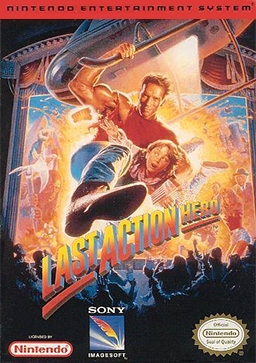
Last Action Hero is a series of action video games based on the 1993 film of the same name. Versions were released for the NES, Super NES, Sega Genesis, Game Boy, Game Gear, and MS-DOS. Versions were also planned for the Sega CD and Master System, but ultimately were not released.
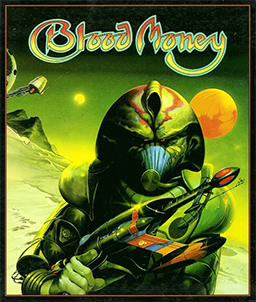
Blood Money is a side-scrolling shooter video game developed by DMA Design and published by Psygnosis in 1989 for the Amiga, Atari ST, and MS-DOS. A Commodore 64 version followed in 1990. The game is set in four different locations on a planet, where the player must fight off enemies and bosses.
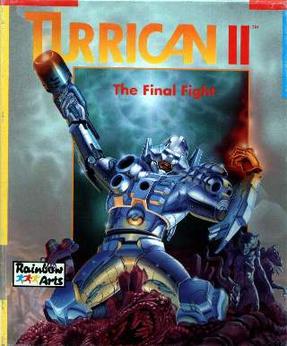
Turrican II: The Final Fight is the second game of the Turrican series. The game, developed by Factor 5 was released in 1991 for the Commodore Amiga. This version was finished before the C64 version, but Manfred Trenz cites the C64 version as the original design. Turrican II was also released for the CDTV, Atari ST, Amstrad CPC and ZX Spectrum, and later for DOS, and also for the Mega Drive/Genesis and Game Boy rebranded as Universal Soldier.

Obitus is an action-adventure game developed and released by Psygnosis in early 1991 for Amiga, Atari ST and DOS. It was also ported to the Super Nintendo Entertainment System by Bullet-Proof Software. The game features both first-person dungeon crawling and side-scrolling gameplay with action-oriented combat and an emphasis on item acquisition. It is similar to games like Eye of the Beholder on Super Nintendo but without the RPG mechanics.

Wrath of the Demon is a 1991 hack and slash video game developed by Quebec-based developer Abstrax, and published by ReadySoft. Versions for Atari ST, Amiga, Commodore CDTV, and MS-DOS were released in early 1991. A Commodore 64 version was released later.

Psygnosis Limited was a British video game developer and publisher headquartered at Wavertree Technology Park in Liverpool. Founded in 1984 by Ian Hetherington, Jonathan Ellis, and David Lawson, the company initially became known for well-received games on the Atari ST and Amiga. In 1993, it became a wholly owned subsidiary of Sony Computer Entertainment (SCE) and began developing games for the original PlayStation. It later became a part of SCE Worldwide Studios. The company was the oldest and second largest development house within SCE's European stable of developers, and became best known for franchises such as Lemmings, Wipeout, Formula One, and Colony Wars.

Puggsy is a 1993 puzzle-platform game developed by Traveller's Tales and released by Psygnosis on the Mega Drive and Mega-CD consoles, as well as the Amiga home computer. Puggsy is the name of the title character, an orange space hopper–like alien who landed his spaceship on The Planet, intending to return home until his spaceship was stolen by the raccoon natives of the planet.

Tim Wright, known professionally as Cold Storage, is a Welsh video game music composer most known for his work in video game soundtracks such as Shadow of the Beast II, Agony, Lemmings, Wipeout and Colony Wars.

Flink is a 2D scrolling platform video game developed by former members of Thalion and published by Psygnosis.
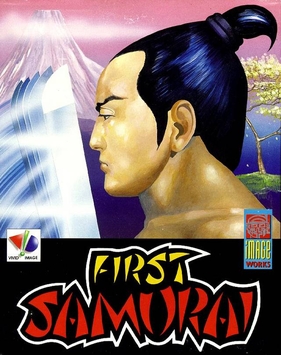
First Samurai, alternatively titled The First Samurai, is a 1991 beat 'em up platform game developed by Vivid Image and published by Image Works. The First Samurai was originally released in September 1991 for the Amiga and Atari ST, and was later ported to the Commodore 64, MS-DOS and the Super Nintendo Entertainment System. It was followed by a sequel, Second Samurai, in 1994. In 2011 a port was released for iOS.

Shadow of the Beast II is a platform game developed by Reflections and published by Psygnosis in 1990. It is the sequel to the earlier Shadow of the Beast.

Lionheart is a platform game for the Amiga developed and self-published by German video game developer Thalion Software in 1993. Using a fantasy motif, the game takes place in the land of the Cat People, a race of feline humanoids, who are threatened by the evil Norka. The player assumes control of Valdyn, an outlaw swordsman who is also known as "Lionheart". Players have to fight their way through 14 levels filled with monsters and environmental hazards. Most of the gameplay is melee combat and precision platforming.
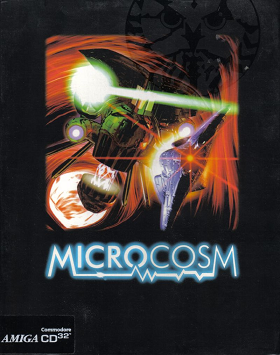
Microcosm is a 3D rail shooter video game developed and published by Psygnosis in 1993. It was originally developed for the FM Towns, and ported for the Sega CD, Amiga CD32, 3DO, and MS-DOS. Microcosm featured realistic FMV animation, with the graphics being rendered on Silicon Graphics workstations. The game is either in first-person or third-person view depending on the gaming system.
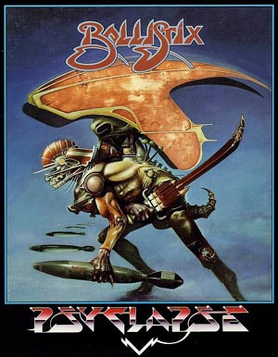
Ballistix is a video game created by Martin Edmondson for the Amiga and Atari ST and published by Psyclapse in 1989. It was also converted to a number of other home computers in the same year and the PC Engine/TurboGrafx-16 console in 1991. It is a fictional futuristic sport involving directing a puck to a goal by shooting small balls at it.

Deathbringer is a 1991 side scrolling action game developed by Oxford Digital Enterprises and published by Empire that was released for the Amiga, DOS, and Atari ST.




















